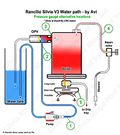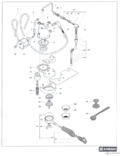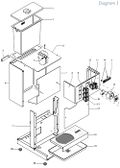(big update) |
|||
| (One intermediate revision by one other user not shown) | |||
| Line 25: | Line 25: | ||
see also the Blue Bottle coffee book's espresso section. | see also the Blue Bottle coffee book's espresso section. | ||
<gallery heights="200px" perrow="6"> | |||
File:Silvia_water_scheme.jpg | |||
File:Rancilio-silvia-pumbing-diagram.png | |||
File:Rancilio-silvia-case-diagram.jpg | |||
</gallery> | |||
== July 2016 Status and Notes == | == July 2016 Status and Notes == | ||
| Line 110: | Line 114: | ||
* both tubes (one plastic, one rubber) go in the water tank. the plastic one is the over-pressure steam release valve | * both tubes (one plastic, one rubber) go in the water tank. the plastic one is the over-pressure steam release valve | ||
* it takes at least 10 minutes to warm up from cold | * it takes at least 10 minutes to warm up from cold | ||
* the water/spill tray isn't very big: fills up fast, needs to be emptied, and | * the water/spill tray isn't very big: fills up fast, needs to be emptied, and is metal so hot if full of hot water. you can use a cup when flushing to reduce the about of water that goes in it. | ||
* leave the portafilter in the machine to keep it warm. this is especially important when the machine is first warming up | * leave the portafilter in the machine to keep it warm. this is especially important when the machine is first warming up | ||
* a good temperature is about 223 F. the PID will overshoot to about 250 F and | * a good temperature is about 223 F. the PID will overshoot to about 250 F and then slowly cool to about that temperature. If you are impatient you can try to cool by running some water through with an empty portafilter (cup button), but then it might react and overshoot again | ||
* with the bottom-less portafilter, you can watch and learn from how the coffee | * the ideal amount of coffee seems to be between 16-18g of coffee. It's easy to weight it out on the scale if you first tare with the portafilter on it. You'll get the feel for this quickly. | ||
* with the bottom-less portafilter, you can watch and learn from how the coffee comes out, but it might splurt around a bit so use a bigger cup | |||
* A good target for a short is between 160-200% of the weight of the coffee that went in and somewhere between 20-30 seconds of extraction time. Adjusting grind, tamping pressure, etc., can help. We've definitely gone pretty far to either end of this. The grinder we have can choke the machine at the very low end. | |||
* after pulling a shot, don't forget to pull out the portafilter and flush some | * after pulling a shot, don't forget to pull out the portafilter and flush some | ||
Latest revision as of 22:16, 30 July 2016
The Extraordinary Least Squares household hosts a souped-up Rancilio Silvia Espresso Machine, which was handed down from a nearby friend. This particular model is quite popular with home espresso aficionados and modders.
What We've Got[edit]
We have a "Rancillio Silvia V1" with a "Fuji Electric PXR3" PID (aka, "temperature controller") installed. Our Silvia also has copper tubing around the boiler to allow pre-heating of water. We also have a fancy Rancillio espresso grinder.
The PID device has a simple interface but fancy features: fuzzy auto-tuning, an RS-485 serial interface for grabbing data, external switch connections for changing modes, etc.
Resources[edit]
- Rancillio Silva V3 Manual (V1 and V3 seem similar?)
- Fuji Electric PXR3 datasheet (mirror)
- Data and PID tuning from somebody with the same setup as us (from ~2016; awesome gnuplot charts): vogie.com
- Silva modding overview website (good background) schneordesign.com
- Here is a visual HOWTO make a whole latte with a Silvia: seattlecoffeegear.com
Here are some diagrams that make it easier to understand how the machine works; see also the Blue Bottle coffee book's espresso section.
July 2016 Status and Notes[edit]
Finally got things wired back up and successfully pulled some shots. Bryan detached the copper tubing and external european high-pressure pump and reconnected the original ("vibrator") pump, which seems to provide plenty of pressure. If we want more pressure we could get a compatible upgrade like this one on amazon: Ulka-EX5
The Silvia casing still hasn't been re-attached, so the machine isn't super safe to use. It would be good to add electrical tape in a couple places before re-assembling, but otherwise it seems to be working well enough that we don't need internal access any more.
The steam wand knob was stuck, but after turning the machine on it got un-stuck; maybe the metal needed to heat up?
The PID settings (tuning, etc) were left as-is, except the set value (target temperature) was changed to 223 F (from 225 F). The steam button does set the set-point to 300 F, but the PID doesn't keep the boiler current on above 260 F or so... not sure if B wasn't following the directions correctly, or maybe there is a safety mode enabled in the PID controller? Note that the PID isn't perfect, it seems to way over-shoot when re-heating after shots, but works well enough. You can flush water through the system to cool it; not sure what effect this has on the actual temperature of water coming out the spout.
Didn't check what the current PID mode or parameters are... if we wanted to start from scratch we could start with these values from vogie.com:
Set duty cycle back to 1 second (from 10 seconds) Set P=3.7% Set Ar=7.50% Set P=3.7% I=85.8S, D=16.5S, AR=7.50%)
The current screen (aka, where the portafilter attaches) has a big old nut in it. Others have complained about this and modded the screen to accept a more flush screw, but this might require a lathe.
Had trouble adjusting the grinder fine-ness. Eventually took the grinder apart partially to clean it out, which greatly helped, and let us go from "as fine as possible" (when spinning by hand could feel the burrs hitting each other) and step back a quarter-dial or so.
Had lots of trouble getting the portafilter in the machine when we filled the basket to the drop and then tamped (leaving the grinds about 2mm below the lip). Maybe because of the screen screw, the portafilter won't even engage or start locking with this much coffee. Needed to only fill up to about the indent line in the basket and then press, which maybe isn't enough coffee. Need a deeper (double) basket?
It's hard to add a fixed about of coffee to the grinder and get it all out. If you don't let the grinder run a long time, it won't finish grinding (slower grinding the finer the grind). A lot of grinds get stuck in the little gap between the burrs the and cylindrical holding ("dosing"?) area. Might be worth reading the manual to see what it says about that.
Operation[edit]
DANGER: the boiler and copper (basically anything copper or brass in the machine), and also the silver head that the portafilter attaches to (and you might be tempted to grab on to when screwing the portafilter in), all get very hot when the machine is on. Careful! Hitting any of the buttons or opening the steam wand at any time can also obviously result in hot water or steam splurting out. Careful! Most of the electrical wiring is 120 V wall mains, and the whole machine is metal and grounded, and there is water around. Careful of electrocution! Don't use metal tools when the machine is plugged in!
IMPORTANT: don't let the motor run for more than 60 seconds, and let it rest for 60 seconds in between long runs ("1 min on / 1 min off"). It's easy for the pump to burn out! When there is a vibrating noise, the pump is on. It's up to you to listen and make sure it isn't running too long.
For the most part, read the Silvia V3 manual for instructions on how to turn the machine on and off, cleaning, and the basic steps for pulling a shot. This describes all the switches and machine-specific stuff. Read the Blue Bottle coffee book's "how to pull a shot" section for basic instructions on how to grind, tamp, what all the terms mean, etc.
Beyond those directions, here are some tips:
- PID will turn on when the machine is plugged in; the power switch doesn't effect it. The boiler won't run when the main power switch is off though, so the PID doesn't do anything in this state (it's just a thermometer)
- both tubes (one plastic, one rubber) go in the water tank. the plastic one is the over-pressure steam release valve
- it takes at least 10 minutes to warm up from cold
- the water/spill tray isn't very big: fills up fast, needs to be emptied, and is metal so hot if full of hot water. you can use a cup when flushing to reduce the about of water that goes in it.
- leave the portafilter in the machine to keep it warm. this is especially important when the machine is first warming up
- a good temperature is about 223 F. the PID will overshoot to about 250 F and then slowly cool to about that temperature. If you are impatient you can try to cool by running some water through with an empty portafilter (cup button), but then it might react and overshoot again
- the ideal amount of coffee seems to be between 16-18g of coffee. It's easy to weight it out on the scale if you first tare with the portafilter on it. You'll get the feel for this quickly.
- with the bottom-less portafilter, you can watch and learn from how the coffee comes out, but it might splurt around a bit so use a bigger cup
- A good target for a short is between 160-200% of the weight of the coffee that went in and somewhere between 20-30 seconds of extraction time. Adjusting grind, tamping pressure, etc., can help. We've definitely gone pretty far to either end of this. The grinder we have can choke the machine at the very low end.
- after pulling a shot, don't forget to pull out the portafilter and flush some



